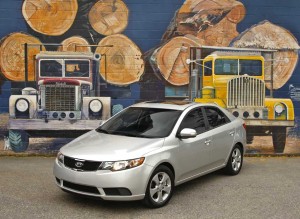
"The foundation of the brand." While the hip new Soul may be gaining Kia some much-needed attention, it's the Forte that will be the brand's volume leader.
In automotive circles, these days, it’s often said that “flat is the new up.” With most major automakers posting hefty double-digit declines, even a single-digit sales dip, is considered a huge success.
So, with its volume off just 6.8 percent, Kia is among the industry’s “winners,” in the ongoing market collapse. That’s all the more true when one considers that the South Korean carmaker’s market share has soared from just 2%, last year to 3.1% during the first five months of 2009.
“While we don’t know how things will work out for the year, as a whole,” suggests Tom Loveless, Kia’s vice president of sales, “we’d have to shut down completely not to post some market share gain in 2009.”
For years, Kia lived in the shadow of its bigger sibling, Hyundai Motors. Suddenly, however, it is carving out an identity of its own. It’s reversing a reputation for quality problems, and it’s launching stand-out products, such as the new Soul crossover, which has been accompanied by what is arguably the year’s most well-received ad campaign, featuring a pair of hip hamsters.
 Long limited to the fringes of the American market, the smaller markets and poor-credit customers, Kia is suddenly attracting a “more desirable” – read affluent and credit-worthy buyer, and now it’s taking aim at the more expensive markets, such as Los Angeles and New York, that it needs to keep its momentum going.
Long limited to the fringes of the American market, the smaller markets and poor-credit customers, Kia is suddenly attracting a “more desirable” – read affluent and credit-worthy buyer, and now it’s taking aim at the more expensive markets, such as Los Angeles and New York, that it needs to keep its momentum going.
“It’s really a question of access,” explains Loveless, who spent many years at Chrysler before joining the Kia management team. “The Top 20 markets are well-established, and the cost of real estate, the simple lack of access to real estate, has made these markets difficult” to penetrate with a viable distribution network.
But Detroit may have inadvertently handed Kia the opportunity it covets. Early this week, a federal bankruptcy judge authorized Chrysler’s plan to drop 789 dealers as it emerges from bankruptcy. And General Motors is looking to eliminate close to 2,000 retailers of its own as it goes through Chapter 11. While many of these retailers are simply expected to shut down, others are seeking alternatives, and Kia could provide one.
“We’re finding ourselves being contacted by dealers interested in the brand who also have a facility available” in a desirable market,” hints Loveless, during a preview of the company’s latest product, the Forte. How many could soon post the Kia logo over their stores is uncertain, but, the executive adds, “We’re probably talking about dozens, not thousands,” that will be added to the current 635 Kia dealers.
If and when they come onboard, these retailers will be representing a product line-up undergoing a rapid evolution. For its first few decades in the American market, Kia was little more than a clone of Hyundai, the larger company that acquired it, some years back, during the meltdown of the Korean auto industry. But after much debate, the two marques are moving in different directions. Though the distinction may be subtle, on paper, Hyundai is targeting competitors like Toyota and Honda, while Kia has its sights on Nissan, Mazda, and with the new Soul, Toyota’s hipper Scion nameplates.
That’s not to say Kia is abandoning its price/value heritage. The Forte, which product strategist Fred Aikens describes as the “foundation of the franchise,” still starts at just over $14,000, including delivery charges. But it’s a markedly more distinctive model than the old, largely indistinguishable Spectra, the sedan it replaces.
With the boxy Soul as its benchmark, Kia plans significant replacements for an array of current models, including the Sorento, Sportage and Optima, and hints other, edgier models will soon join the line-up.
There are still plenty of issues to overcome. Kia’s quality is on the rise, though it’s still far from matching the benchmark, Tier One Japanese. Its 10-year warranty, however, has helped overcome consumer concerns.
Then there’s the consideration factor. Like Hyundai, the smaller Korean brand has only been able to wiggle its way onto the shopping list of a small number of buyers, perhaps one in five actively in the market. But company officials insist that so-called focus groups reveal that potential customers are no longer turning up their noses when they discover that a cool new product, like Soul, is actually a Kia.
“We don’t expect to go to bed, one night and wake up the next morning a new brand in people’s minds,” admits Loveless, adding that it’s a “gradual” process, that starts with building awareness and then improving perceptions.
Kia has generated 14 consecutive years of market share gains and is confident it will make it 15, this year. The real challenge will come with the anticipated recovery, but the momentum is clearly in the right direction.
